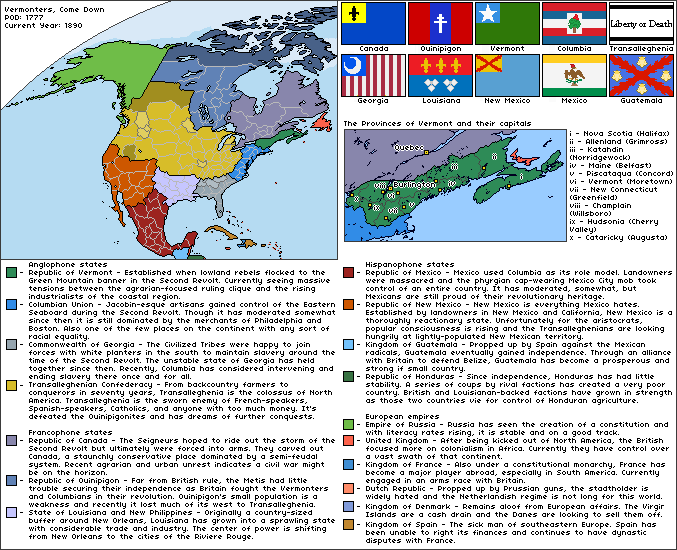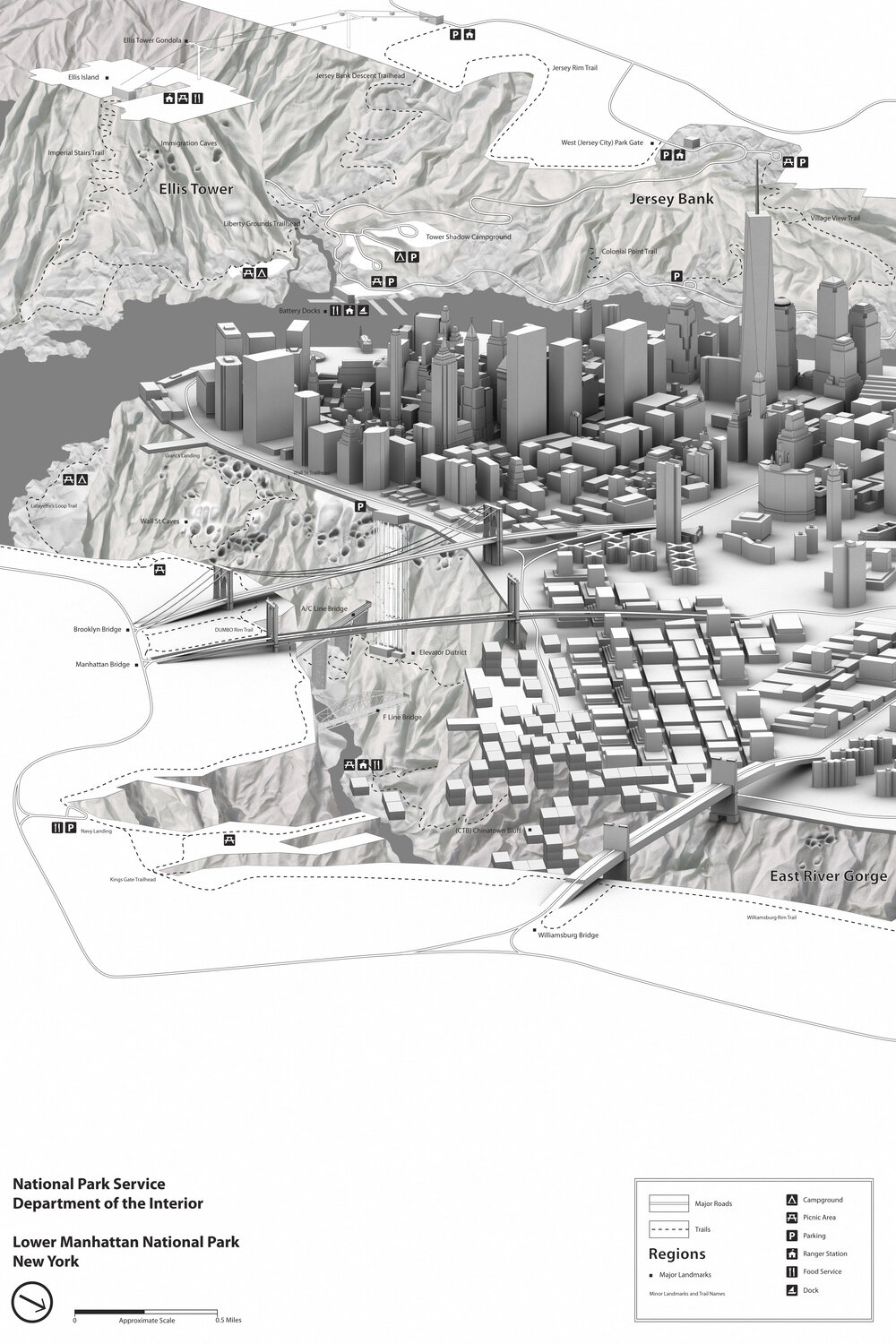I wanted to make a Vermont wank. This is what I came up with. The write-up is admittedly a bit short so if you have any questions, ask away.
The twin defeats of the Continental Army at Brandywine Creek and Bemis Heights in September 1777 were a massive setback for the Patriot cause. With Philadelphia and New York in British hands, the Continentals wintered on the frontier, seeing mass desertions and a loss of unit cohesion. Their civilian relations gradually soured on the revolt, and began to return to the loyalist fold. Washington and his army were squarely defeated in March 1778 at Bethlehem and prevented from linking up with the northern wing of the army, which was marching south from New York. Captured fleeing Bethlehem, Washington declared the Continental cause hopeless, and, by the end of the year, conventional resistance to the British was over. In the backcountry, groups like the Green Mountain Boys and the Overmountain Men continued to strike against the redcoats, but no army of any real size emerged to contest control of the colonies. Many of the old colonial charters were revoked and the governments reorganized to prevent the ability of future rebels to organize large areas while Patriot leaders were executed or sent into exile.
Decades passed and patriotic fervor subsided. Attacks on symbols of British authority continued in the cities from die-hard radicals but the colonies were, for a time, calm. In several regions, resistance did continue. The Green Mountain Boys practically ruled in some of the valleys of the land they called Vermont while hostility to tax collectors and government officials was commonplace in the Transappalachian west. By the start of the 1810s, things began to change. In the west, the old Proclamation Line had worn away, but British authorities had given tribes in the Ohio Valley privileges settlers felt they should not have. In the east, there was anger at a lack of representation for colonists and displeasure with some heavy-handed British colonial governors.
The Second Revolt began at Covington (OTL Louisville, Kentucky) in August 1818. Angry at a high-profile case in which a native man murdered a white settler and then went unpunished, colonists gathered to present their petition to a local magistrate. They were ignored and a riot began, ending with the beating of the magistrate. This spurred other riots around the Ohio Valley, ending with a Declaration of Independence in November. The newly-minted Transalleghenian Confederacy hastily raised an army and engaged in war against the British and their native allies. The war in the backcountry raged for three years, prompting debate among colonists in the Thirteen Colonies (though those colonies no longer existed, the name stuck for the region) and Canada. Volunteers struck out for the west, hoping to fight against the crown, but there was little action outside of the Ohio Valley and Tennessee. Then came a call for a draft. Britain proposed to send colonial militias against the Transalleghenians. This was too much. Mutinies against British officers prompted reprisals and slow-simmering resentment broke out into full-fledged conflict.
The start and end dates of the period called the Second Revolt are widely debated. The Thirteen Colonies had burst into revolt by the summer of 1821 and were followed in 1822 by Canada. British actions against the Transalleghenians ended in 1824 while some of the rebels of the Thirteen Colonies and Canada continued to fight until 1828, when they gained their independence. It was a messy period filled with fighting between many sides. In the east, one of the most potent factions was Vermont. The Green Mountain Boys continued their guerrilla campaigns after 1778 and even served as a de facto government in some towns where even British colonial police were afraid to go. When popular resentment against the crown burst into revolt, many in regions surrounding Vermont took up the banner of the Green Mountain and declared themselves loyal to the Second Vermont Republic. Further south, the radicals of the coastal cities were dominant as the Vermonters were seen as bumpkins. In these cities, the rebels established Columbia, a state where their ideals of liberty and equality have held true.
Spain provided aid to the rebels but quickly realized their mistake as the spirit of revolutionary nationalism struck in Spanish colonies, which sparked uprisings across Latin America. Spain's generosity towards the rebels of Columbia was unrequited as the Columbians set frigates to aid the republican rebels in Mexico. North America has now been dominated by independent powers for half a century and is a peaceful place. To be sure, there have been wars and rebellions, but by and large the disputes of the continent have been settled with diplomacy rather than by the sword. The biggest exception to this rule is in Transalleghenia, where the expansionistic spirit has remained strong and the country's leaders believe that the lands of its neighbors must be subordinated to Transalleghenia. The European Empires have a limited presence, except in the Caribbean, where their colonies are facing a growth in nationalism and pro-independence sentiments.

- - -
The twin defeats of the Continental Army at Brandywine Creek and Bemis Heights in September 1777 were a massive setback for the Patriot cause. With Philadelphia and New York in British hands, the Continentals wintered on the frontier, seeing mass desertions and a loss of unit cohesion. Their civilian relations gradually soured on the revolt, and began to return to the loyalist fold. Washington and his army were squarely defeated in March 1778 at Bethlehem and prevented from linking up with the northern wing of the army, which was marching south from New York. Captured fleeing Bethlehem, Washington declared the Continental cause hopeless, and, by the end of the year, conventional resistance to the British was over. In the backcountry, groups like the Green Mountain Boys and the Overmountain Men continued to strike against the redcoats, but no army of any real size emerged to contest control of the colonies. Many of the old colonial charters were revoked and the governments reorganized to prevent the ability of future rebels to organize large areas while Patriot leaders were executed or sent into exile.
Decades passed and patriotic fervor subsided. Attacks on symbols of British authority continued in the cities from die-hard radicals but the colonies were, for a time, calm. In several regions, resistance did continue. The Green Mountain Boys practically ruled in some of the valleys of the land they called Vermont while hostility to tax collectors and government officials was commonplace in the Transappalachian west. By the start of the 1810s, things began to change. In the west, the old Proclamation Line had worn away, but British authorities had given tribes in the Ohio Valley privileges settlers felt they should not have. In the east, there was anger at a lack of representation for colonists and displeasure with some heavy-handed British colonial governors.
The Second Revolt began at Covington (OTL Louisville, Kentucky) in August 1818. Angry at a high-profile case in which a native man murdered a white settler and then went unpunished, colonists gathered to present their petition to a local magistrate. They were ignored and a riot began, ending with the beating of the magistrate. This spurred other riots around the Ohio Valley, ending with a Declaration of Independence in November. The newly-minted Transalleghenian Confederacy hastily raised an army and engaged in war against the British and their native allies. The war in the backcountry raged for three years, prompting debate among colonists in the Thirteen Colonies (though those colonies no longer existed, the name stuck for the region) and Canada. Volunteers struck out for the west, hoping to fight against the crown, but there was little action outside of the Ohio Valley and Tennessee. Then came a call for a draft. Britain proposed to send colonial militias against the Transalleghenians. This was too much. Mutinies against British officers prompted reprisals and slow-simmering resentment broke out into full-fledged conflict.
The start and end dates of the period called the Second Revolt are widely debated. The Thirteen Colonies had burst into revolt by the summer of 1821 and were followed in 1822 by Canada. British actions against the Transalleghenians ended in 1824 while some of the rebels of the Thirteen Colonies and Canada continued to fight until 1828, when they gained their independence. It was a messy period filled with fighting between many sides. In the east, one of the most potent factions was Vermont. The Green Mountain Boys continued their guerrilla campaigns after 1778 and even served as a de facto government in some towns where even British colonial police were afraid to go. When popular resentment against the crown burst into revolt, many in regions surrounding Vermont took up the banner of the Green Mountain and declared themselves loyal to the Second Vermont Republic. Further south, the radicals of the coastal cities were dominant as the Vermonters were seen as bumpkins. In these cities, the rebels established Columbia, a state where their ideals of liberty and equality have held true.
Spain provided aid to the rebels but quickly realized their mistake as the spirit of revolutionary nationalism struck in Spanish colonies, which sparked uprisings across Latin America. Spain's generosity towards the rebels of Columbia was unrequited as the Columbians set frigates to aid the republican rebels in Mexico. North America has now been dominated by independent powers for half a century and is a peaceful place. To be sure, there have been wars and rebellions, but by and large the disputes of the continent have been settled with diplomacy rather than by the sword. The biggest exception to this rule is in Transalleghenia, where the expansionistic spirit has remained strong and the country's leaders believe that the lands of its neighbors must be subordinated to Transalleghenia. The European Empires have a limited presence, except in the Caribbean, where their colonies are facing a growth in nationalism and pro-independence sentiments.


